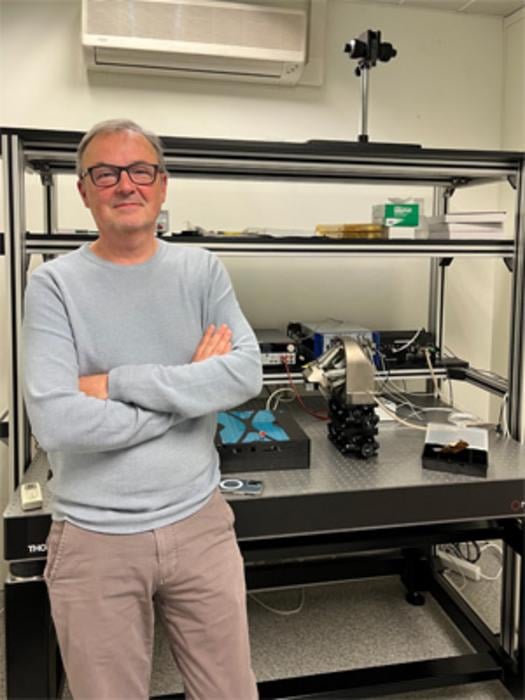
Photonic Processor Boosts Multifunctionality for Next-Gen Networks and AI
VALENCIA, Spain, May 6, 2024 — A team from the Photonics Research Laboratory (PRL)-iTEAM of the Universitat Politècnica de València (UPV) and the company iPRONICS have developed a multifunctional, programmable photonic processor for applications in the telecommunications sector, data centers, and infrastructure for AI computing systems. The device leverages properties found in photonic systems such as high bandwidth and speed, while working synergistically with electronic processors.
Ultrahigh speed 5G and 6G mobile networks, artificial intelligence (AI) computing, and other state-of-the-art applications strain the existing infrastructures that connect the wireless and fiber segments in communication networks. The multifunctional, programmable silicon photonic processor can connect wireless and photonic segments of communication networks, increasing bandwidth and reducing power consumption.

UPV professor José Capmany (pictured) led a collaboration with iPRONICS that yielded a multifunctional, programmable photonic processor. Courtesy of UPV.
“It is the first chip in the world with these characteristics,” said UPV professor José Capmany. “It can implement the twelve basic functionalities required by these systems and can be programmed on demand, thus increasing the efficiency of the circuit.”
MWP systems use optical devices and techniques to generate, manipulate, transport, and measure high-speed radio frequency (RF) signals. Until now, most MWP applications have been implemented by application-specific photonic integrated circuits (ASPICs).
Prior demonstrations of MWP using ASPICs have been limited to the implementation of one functionality, with minimal reconfigurability and flexibility. The programmable photonic processor overcomes these limitations by providing full flexibility in terms of functionality selection and parameter reconfiguration for the selected application. The programmable photonic processor, to the best of the team’s knowledge, is the first photonic processor to integrate the challenging technology stack needed to implement all the main functionalities found in individual MWP systems.
For example, because applications like 5G and autonomous cars require a higher frequency, it is necessary to shrink the size of the antennas and associated circuits in these applications. Using the programmable photonic processor technology, the UPV team made the converter behind the antenna as compact as possible to support current and future frequency bands.
The researchers demonstrated that simultaneous implementation of several functionalities in the photonic core is possible with the programmable photonic processor, and therefore, parallel processing operations are feasible. The team’s findings indicate that the photonic processor can work in frequency ranges of up to 100 GHz featuring power consumption values in the order of a few watts. The ability to implement all the functionalities with a single processor will make it possible to scale down the processor size to dimensions compatible with next-generation, millimeter wave base stations and satellites, and use the processors for custom applications.
The gains that can be achieved by replacing electronic subsystems with programmable photonic processors include ultrahigh bandwidth, high-speed operation, and low power consumption. Programmable photonic processors also provide flexibility, reduce engineering costs, and reduce fabrication costs by leveraging economies of scale. They provide the ability to reuse resources, which can increase sustainability.
These capabilities are key in applications such as next generation 5G and 6G wireless systems, where reconfigurable filtering, frequency conversion, arbitrary waveform generation, and beamforming are currently provided by MWP subsystems that cannot be scaled down. The new photonic processor could help meet the stringent processing requirements of mobile-based applications and enable a new generation of compact, broadband, programmable devices.
The programmable photonic processor can realize these benefits while operating in a complementary, synergistic way with electronic processors.
The processor has already been integrated into an iPRONICS product called the Smartlight and Vodafone has used it in testing.
“For us, the development of this chip is a crucial step because it has allowed the validation of our developments applied to a growing problem — the efficient management of data flows in data centers and networks for artificial intelligence computing systems,” Daniel Pérez-López, co-founder and CTO of iPRONICS, said. “Our next goal is to scale the chip to meet the needs of this market segment.”
In addition to AI and 5G/6G networks, the multifunctional, programmable photonic chip could benefit many other applications, including data centers, quantum computing, satellite, lidar, drone technologies, and autonomous driving.
The research was published in Nature Communications (www.doi.org/10.1038/s41467-024-45888-7).
/Buyers_Guide/iPRONICS/c32667